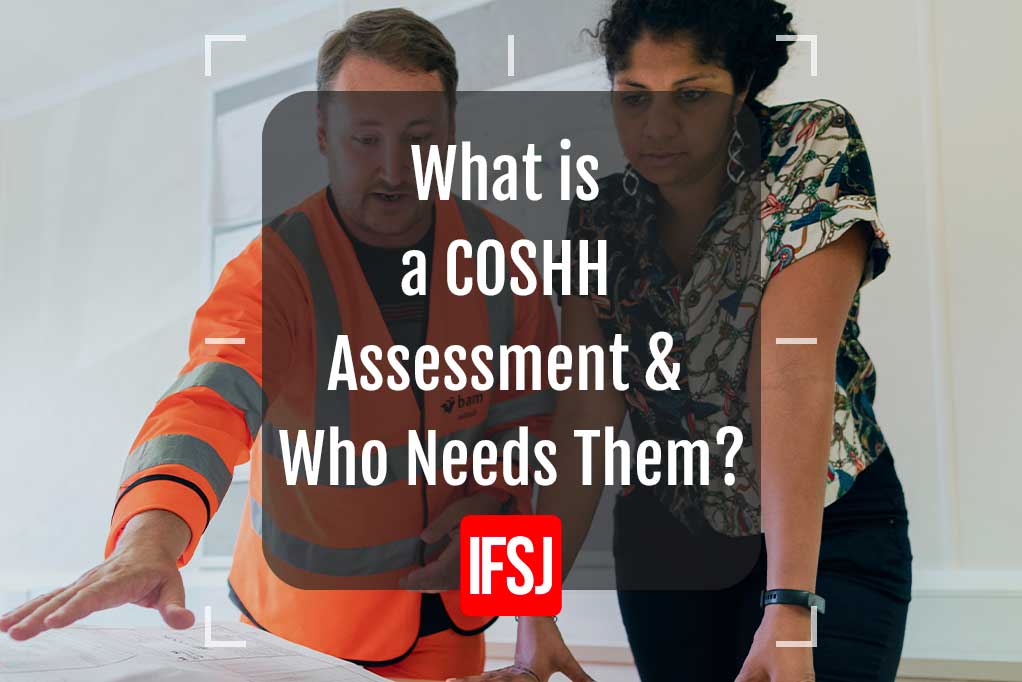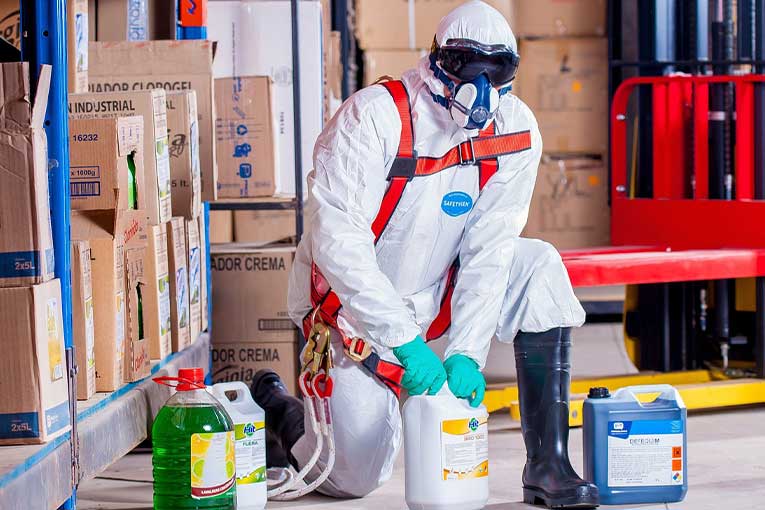What is a COSHH Assessment & Who Needs Them?
- February 7, 2024
- 8:00 am


Simon Burge
Share this content
Workplace safety is of the utmost importance and understanding and implementing proper risk assessments is paramount.
One such essential assessment is COSHH, short for Control of Substances Hazardous to Health.
The COSHH assessment aims to safeguard employees and others from potential harm due to exposure to hazardous substances in the workplace.
What is a COSHH Assessment?

A COSHH assessment is a crucial process designed to systematically manage and mitigate the risks linked to hazardous substances within a workplace.
The fundamental objective is to safeguard the health and well-being of individuals exposed to these substances during various work activities.
The assessment encompasses a broad spectrum of materials, not just limited to traditional chemicals.
It includes biological agents, dust, fumes, and other substances that have the potential to pose health risks.
This systematic evaluation ensures that any potential harm associated with these substances is identified and effectively controlled.
COSHH assessments play a pivotal role in fostering a secure work environment.
By scrutinising all substances within the workplace that could be considered hazardous, this process enables organisations to take proactive measures to minimise risks and adhere to regulatory standards.
The systematic steps involved in a COSHH assessment, from identifying hazardous substances to evaluating control measures, contribute to the creation of a detailed and effective risk management plan.
Through documentation, communication, and training, a COSHH assessment becomes a cornerstone in promoting awareness and understanding among personnel about the potential risks associated with hazardous substances and the measures in place to mitigate them.
Overall, it is an indispensable tool for organisations committed to maintaining a safe and healthy workplace.
Who Needs to have a COSHH Assessment?

Any business where employees are exposed to hazardous substances requires a COSHH assessment.
This includes but is not limited to:
Manufacturing and Industry
Industries that involve the use of chemicals, solvents, or other hazardous substances in processes or production.
Healthcare
Hospitals, clinics, and other healthcare settings where various substances, including cleaning chemicals and pharmaceuticals, are utilised.
Laboratories
Research facilities and testing laboratories dealing with chemicals and biological agents.
Construction
Sites where workers may encounter substances like dust, adhesives, or paints.
Cleaning Services
Companies involved in cleaning, janitorial, or sanitation services using various cleaning agents.
Agriculture
Farms and agricultural settings where pesticides, fertilisers, and other chemicals are employed.
Retail
Businesses that sell products containing hazardous substances, such as paints, adhesives, or cleaning supplies.
Office Environments
Even seemingly low-risk environments may have substances like cleaning chemicals that require assessment.
Educational Institutions
Schools, colleges, and universities where laboratories and workshops involve the use of various chemicals.
How Often Should a COSHH Assessment be Done?
According to COSHH Regulations, there is no set frequency specified for how often a COSHH assessment should be conducted.
Instead, it is a dynamic process that depends on the nature of the work, the substances involved, and any changes in the workplace that may affect exposure.
The law requires that COSHH assessments be carried out systematically and be reviewed regularly.
The Health and Safety Executive (HSE) advises that assessments should be reviewed if there is any reason to suspect they are no longer valid or if there has been a significant change in the workplace or work processes.
For example, if new substances are introduced into the workplace, processes change, or if there is evidence that control measures are not effective, a review of the COSHH assessment is necessary.
This flexible approach allows for the adaptation of safety measures to the evolving nature of work environments.
It’s crucial for employers to stay vigilant and ensure that COSHH assessments are not treated as a one-off task but rather as an ongoing process that reflects the dynamic nature of workplaces.
Regular reviews help in identifying emerging risks and adjusting control measures accordingly.
Failure to regularly review COSHH assessments can lead to a workplace being ill-prepared to manage new risks, potentially endangering the health and safety of employees.
What Happens in a COSHH Assessment?

Here’s an in-depth look at what happens during a COSHH assessment:
Identification of Hazardous Substances
The process begins with identifying all the hazardous substances used, stored, or generated in the workplace.
This includes any substances that could pose a risk to health.
Assessment of Risks
Once identified, the next step is to assess the risks associated with these substances.
This involves evaluating how employees might be exposed, the potential harm it could cause, and the likelihood of that harm occurring.
Evaluation of Control Measures
The effectiveness of existing control measures is examined.
This includes ventilation systems, personal protective equipment (PPE), safe work procedures, and any other measures in place to minimise exposure.
The assessment considers whether these measures are sufficient or if additional controls are needed.
Recording and Documentation
All findings are recorded, and a written assessment is created.
This document outlines the identified hazards, the risks associated, and the control measures in place.
This serves as a reference for employees, management, and regulatory bodies.
Review and Update
The assessment is not a one-time task. It needs to be regularly reviewed and updated, especially when there are changes in work processes, substances used, or if control measures prove ineffective.
This ensures that the assessment remains relevant and effective over time.
Communication and Training
Employees need to be informed about the hazards associated with the substances they work with and the measures in place to protect them.
Training is essential for ensuring that everyone understands the risks and knows how to use control measures effectively.
Emergency Planning
In the event of an emergency, such as a spill or exposure, there should be clear plans and procedures in place.
This could include evacuation plans, first aid procedures, and emergency contact information.
Consultation with Employees
Employees should be actively involved in the assessment process.
They are often the ones with valuable insights into the practical aspects of their work, and their input can contribute to a more comprehensive and effective assessment.
How can you Minimise Risks in a COSHH Assessment?
Here are strategic approaches to minimise these risks:
Robust Employee Training
Ensuring that employees are well-versed in handling hazardous substances is paramount.
Training should cover the proper usage of personal protective equipment (PPE), safe handling procedures, and emergency response protocols.
An educated workforce is a critical line of defence against potential risks.
Effective Ventilation Systems
Investing in and maintaining effective ventilation systems is pivotal.
Adequate ventilation minimises the concentration of hazardous substances in the air, reducing the risk of inhalation and airborne contamination.
Stringent Control Measures
Implementing stringent control measures, such as engineering controls and administrative procedures, is essential.
This could include enclosure systems, fume hoods, or designated work practices that limit exposure.
Regular Health Surveillance
Conducting regular health surveillance of employees exposed to hazardous substances is a proactive measure.
Monitoring their health allows for early detection of adverse effects and the adjustment of control measures as needed.
Substitution of Hazardous Substances
Exploring less hazardous alternatives or substitutes for substances in use is a powerful risk reduction strategy.
Where feasible, replacing hazardous substances with safer alternatives minimises potential harm.
Adequate Storage and Handling Protocols
Establishing and enforcing proper storage and handling protocols is critical.
This involves secure storage, clearly labelled containers, and meticulous procedures to prevent spills or accidental exposure.
Emergency Response Planning
Having a robust emergency response plan is non-negotiable.
This includes clear procedures for spills, leaks, or unintended exposures.
Employees should be well-trained on emergency protocols, including evacuation routes and first aid procedures.
Regular Audits and Inspections
Frequent audits and inspections ensure that control measures are consistently implemented and effective.
Identifying and rectifying any lapses promptly enhances the overall safety of the workplace.
Conclusion
COSHH assessments are not just regulatory requirements; they are fundamental tools for ensuring workplace safety.
Whether you are in a chemical manufacturing plant or a bakery, identifying and controlling hazards is critical.
By understanding the significance of COSHH assessments and actively implementing their findings, businesses can create safer environments for their workforce, promoting health, well-being, and overall productivity.

